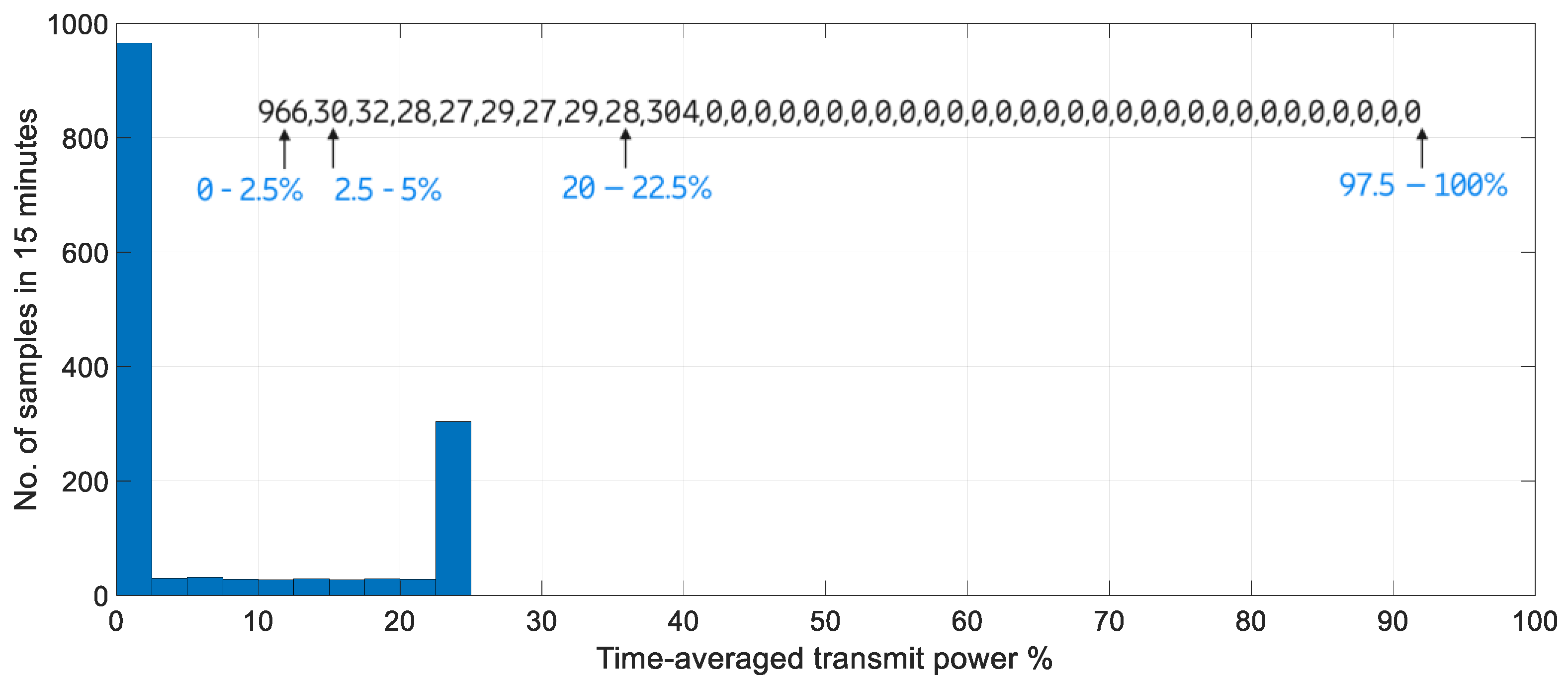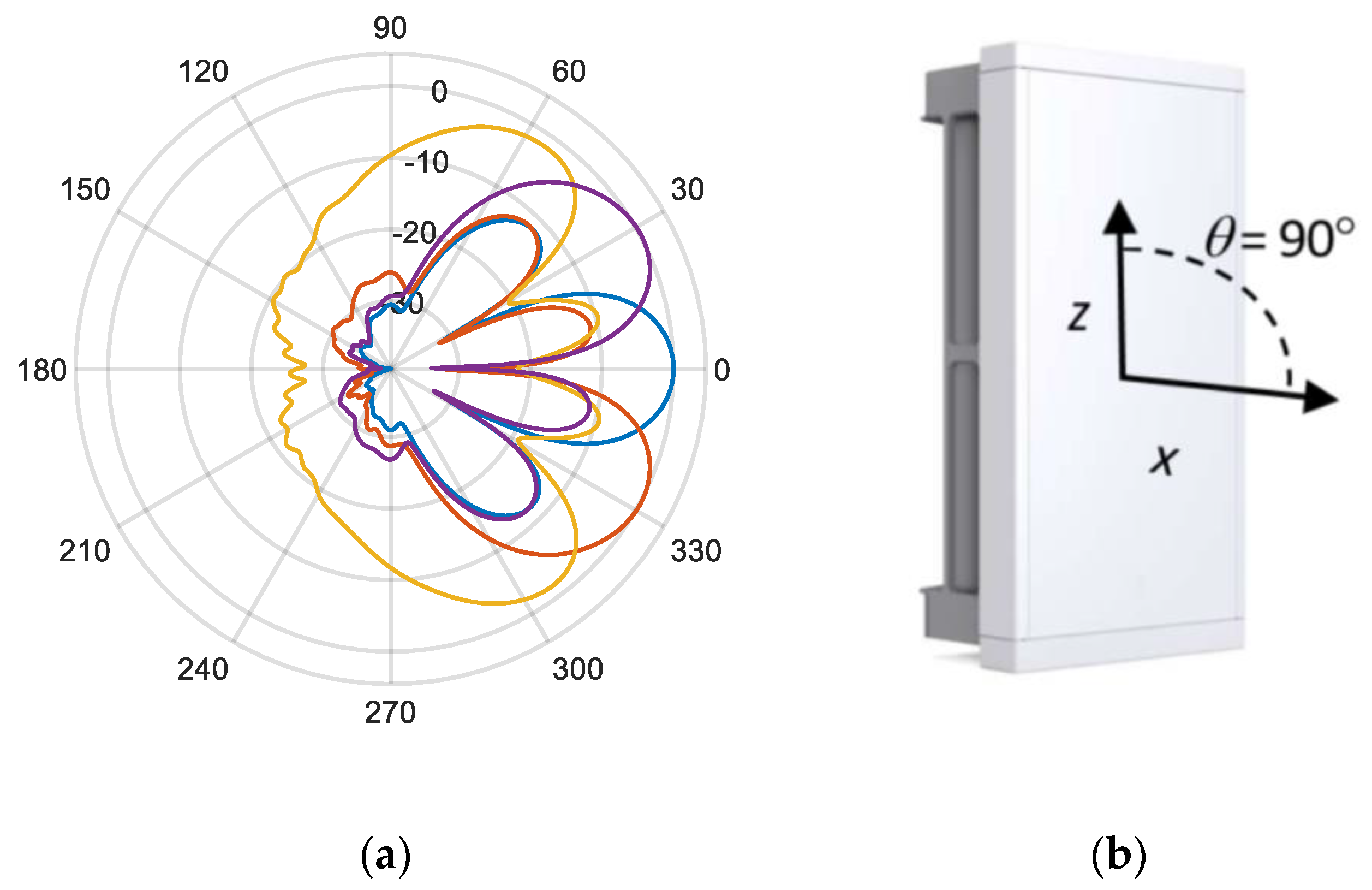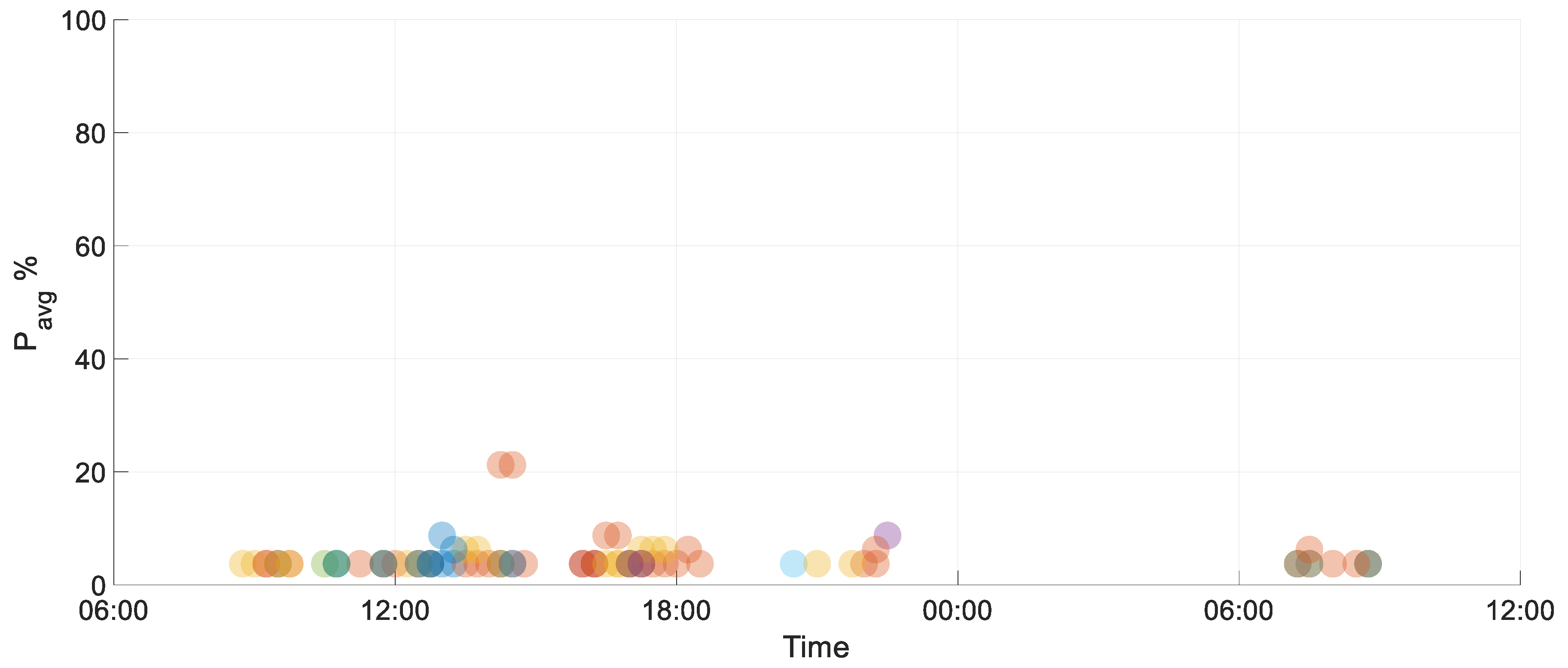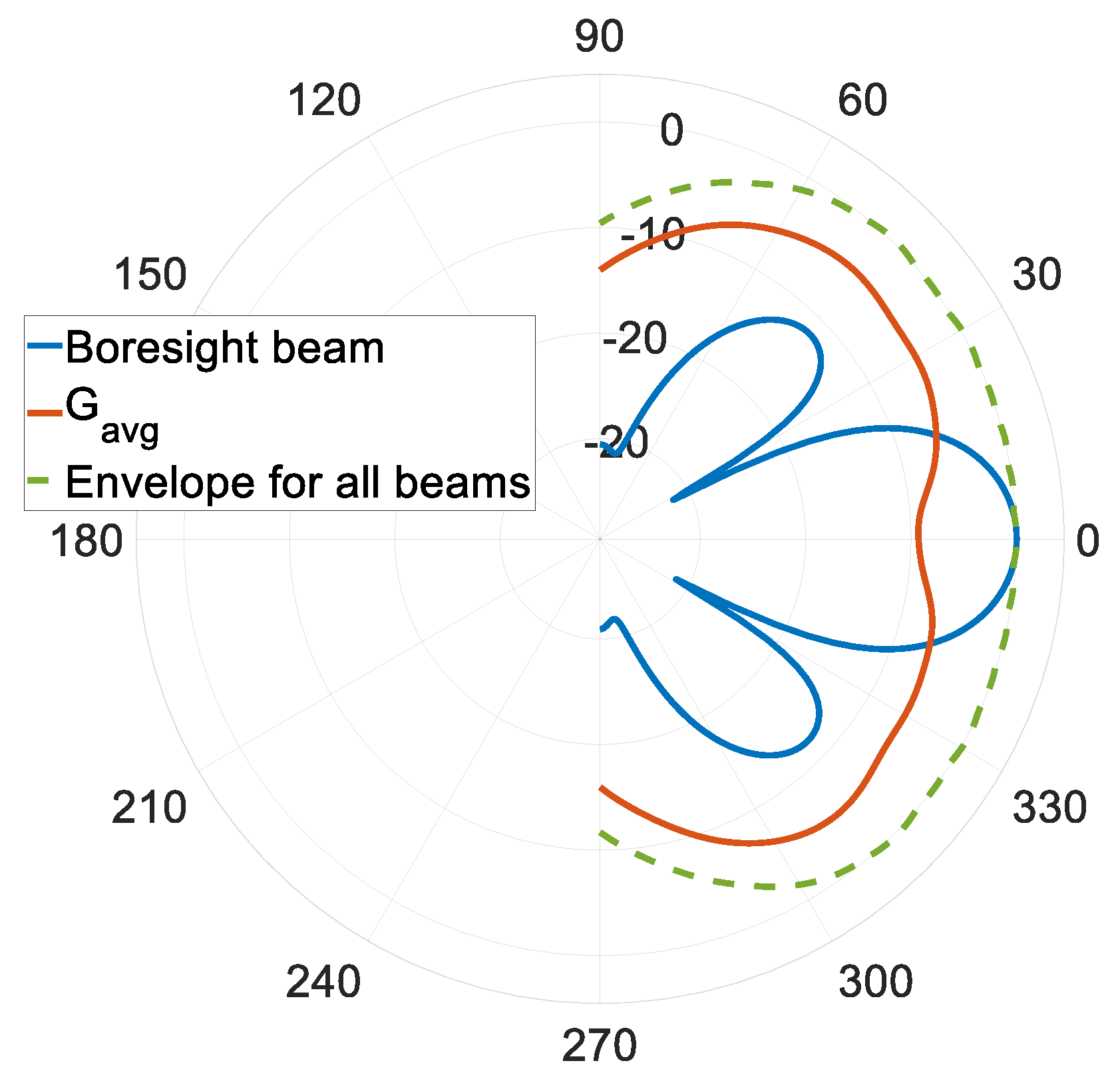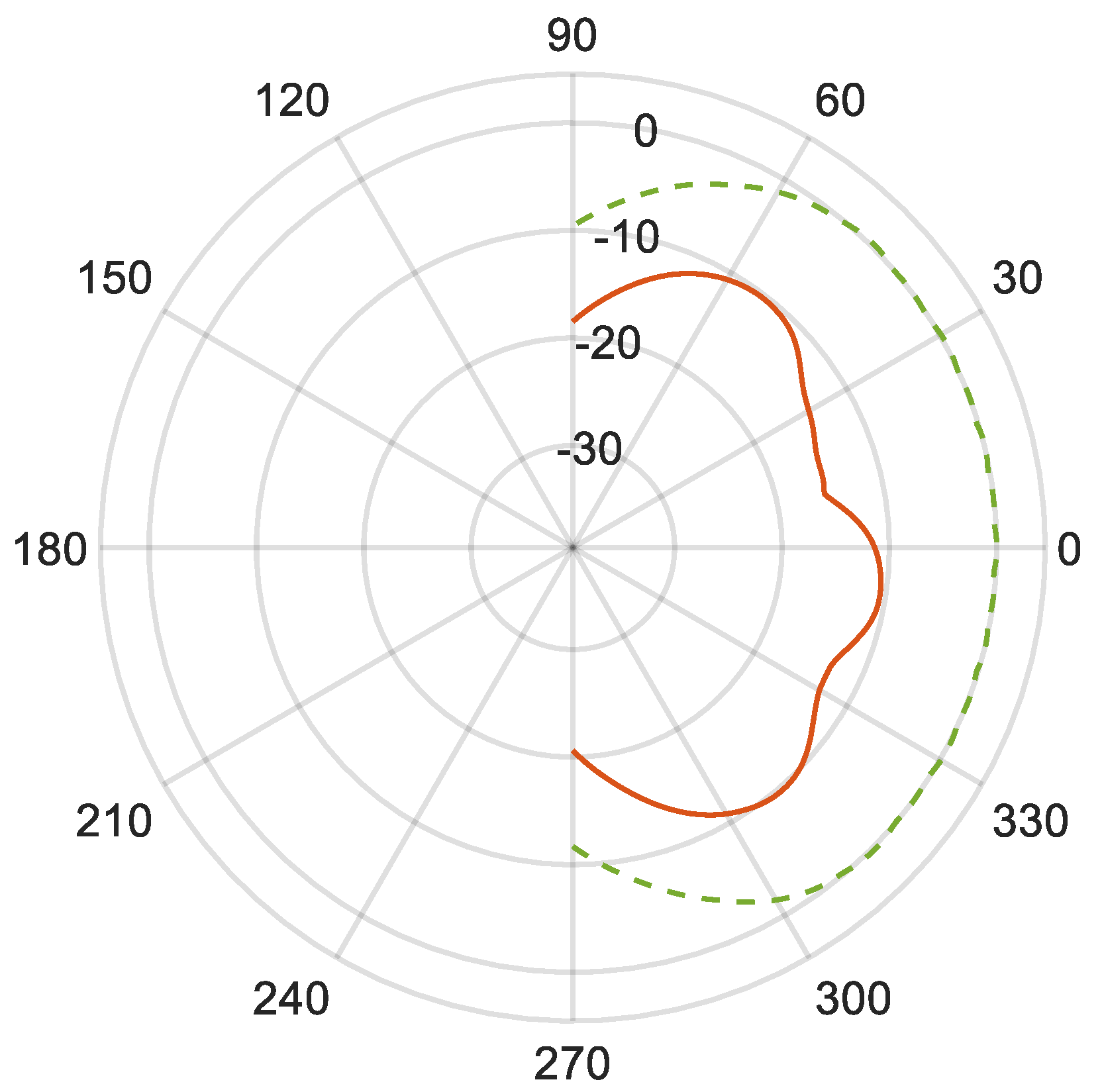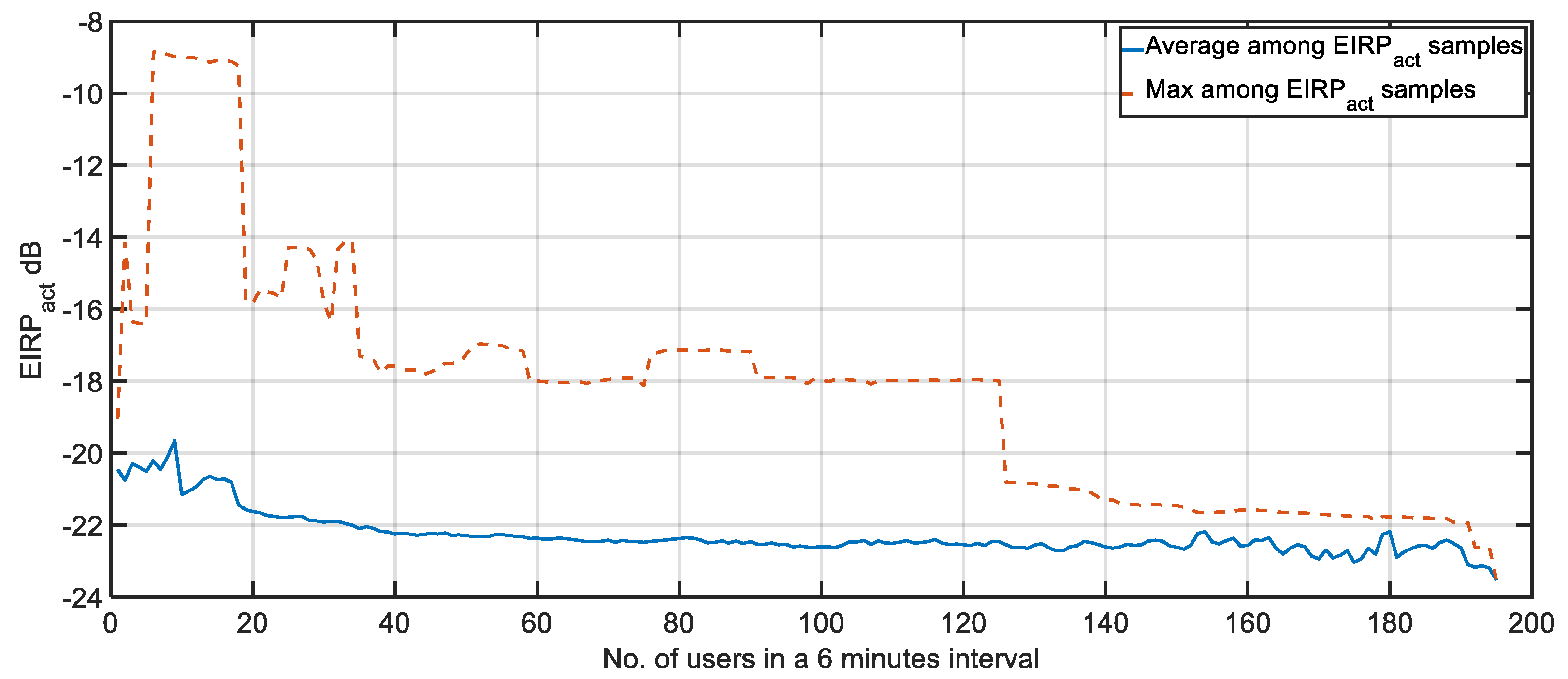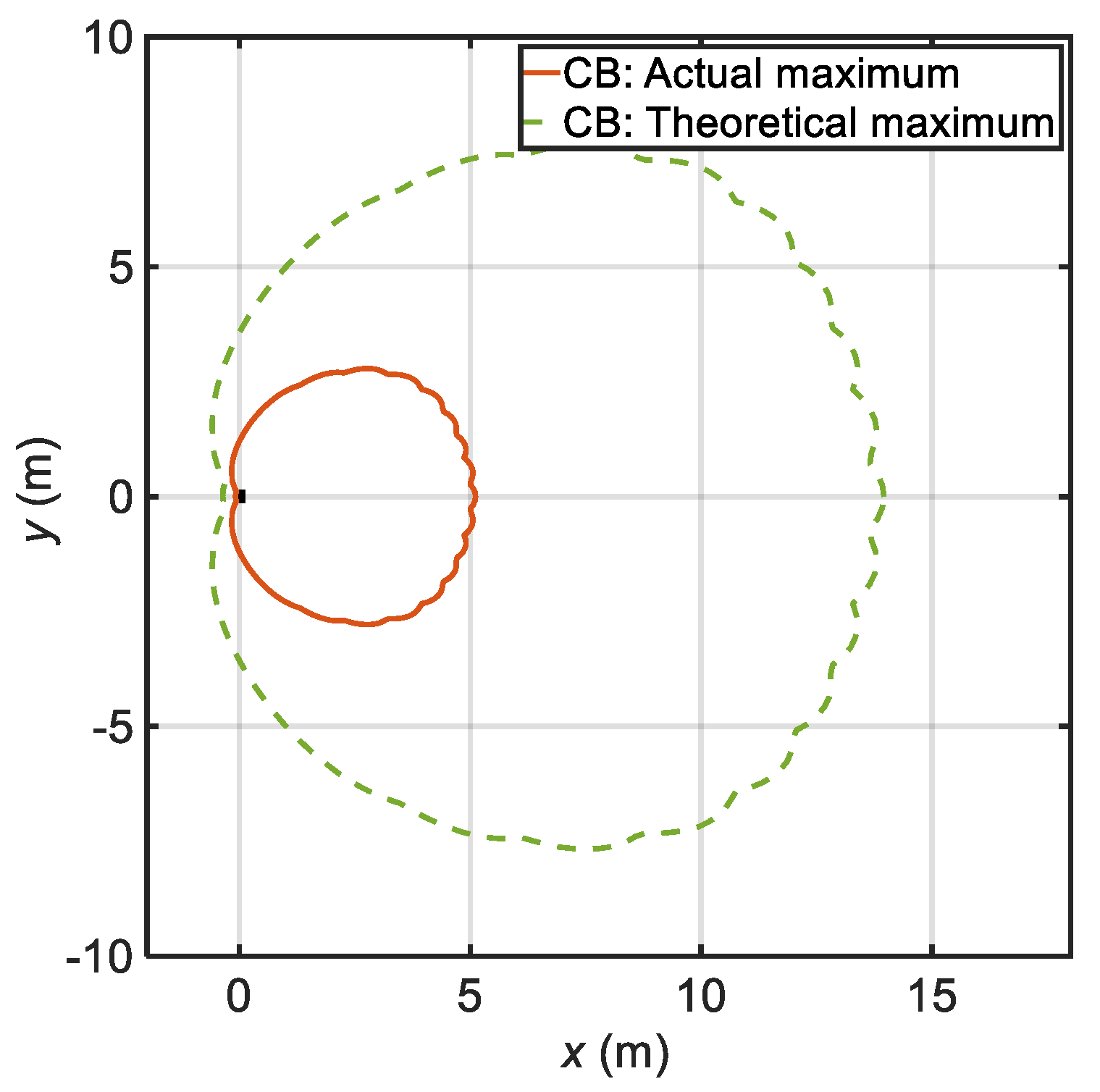1. Introduction
The first 5G NR (new radio) commercial networks were launched in 2019, and the number of 5G subscriptions globally reached 13 million by the end of 2019 [
1]. Like any other radio access technology, 5G base stations (BSs) have to comply with radiofrequency (RF) electromagnetic field (EMF) exposure limits, such as those specified by the International Commission on Non-Ionizing Radiation Protection [
2]. EMF measurement surveys of 5G BSs have been conducted in some countries [
3,
4], and typical exposure levels in areas accessible by the general public were found to be thousands of times below the limit values and similar to those of other existing mobile technologies (2G, 3G, and 4G).
5G makes use of beamforming and beam steering to adapt the antenna radiation pattern to the time-varying traffic and the radio propagation conditions. This allows it to efficiently direct the energy where needed, providing enhanced performance to the users. To be able to steer the beams over a range of angles, BS products make use of array antennas characterized by many elements, generally known as massive MIMO antennas. Compared with conventional non-beamformed systems, massive MIMO BSs are characterized by a larger variability of transmitted signals in time and space. In order to take this into account, specific measurement techniques to assess the exposure levels in proximity of 5G massive MIMO BSs have been developed [
5,
6,
7].
The effects of beamforming and traffic variation on the EMF exposure levels have been studied by means of numerical simulations and statistical models [
8,
9]. Based on conservative assumptions on the data traffic and on the user distributions, these studies estimate the BS maximum power level contributing to EMF exposure in any beam direction. Since the beams are steered in order to provide service to the connected users, the time-averaged power in each beam direction was found to be well below the instantaneous peak (or theoretical maximum). According to [
8], the 95th percentile of the transmitted power per beam would range between 7% and 22% of the theoretical maximum. These results have been verified by measurements conducted on massive MIMO BSs [
10,
11] of 4G LTE-Advanced networks. While a substantial amount of research available to date already shows that massive MIMO BSs do not constantly operate at the maximum power, experimental data specific for 5G live networks are yet not available.
In this study, a large amount of experimental data of relevance for EMF exposure was collected from a 5G NR commercial network. The dynamic of the spatial distribution of the transmit power serving 5G users was continuously monitored for 25 massive MIMO BSs over 24 h. Data were extracted from network counters and events, which directly provide information on the BS baseband operations. In addition to the time-averaged transmit power, information on the beams scheduled by the BSs when serving the connected users is obtained and processed. By this knowledge, the spatial distribution of the transmit power was determined. The method is developed in
Section 2 and results on the actual power are given in
Section 3. A discussion, including implications of the results on EMF exposure from massive MIMO BSs is provided in
Section 4 and some conclusions are drawn in
Section 5.
This work is of interest to support the ongoing revision of IEC 62232 [
5], which provides methods to conduct EMF compliance assessment of massive MIMO BSs by taking the effects of beamforming into consideration. The availability of 5G experimental data can be relevant to regulators when defining guiding principles on the usage of the actual maximum power to avoid unrealistic estimates of the EMF exposure levels.
2. Method
Measurement data were collected from 25 NR BSs of the Telstra commercial network in Australia. Telstra was among the first operators to launch 5G, and in January 2020, more than 100,000 5G-enabled mobile devices were connected to its network [
12]. The massive MIMO BSs selected for this study were located in dense urban areas, typically characterized by higher traffic than rural areas. The BSs operated within the NR band 78 (3300–3800 MHz) with a channel bandwidth varying among the sites and ranging from 40 to 80 MHz. The time division duplexing (TDD) downlink duty cycle, which is defined as the fraction of the time available for downlink transmission to the total transmission time, was about 75%.
Ericsson Network Manager (ENM) was used to access information on the 5G BSs operation for 24 h over a weekday at the end of January 2020. By means of gathering data directly through the ENM, it was possible to simultaneously collect information and statistics for many sites over a relatively long period. Moreover, it allowed us to analyze the spatial distribution of the BS transmit power in a three-dimensional space within the scan range of the antenna rather than having to conduct measurements at a fixed location.
The transmit power per direction or more specifically the equivalent isotropic radiated power (EIRP) in azimuth and elevation () was determined as a function of time by continuously logging two metrics:
The total (cell-wide) time-averaged transmit power, ;
The time-averaged gain, .
While the recently updated exposure guidelines, ICNIRP [
2], have extended the averaging time applicable to whole-body exposure to thirty minutes, six minutes was applied in this study according to the previous version of the ICNIRP guidelines [
13]. This choice was made in order to allow a direct comparison with what was predicted by the statistical models, e.g., [
8], published when [
2] was not yet available. Moreover, it might take some time until the updated ICNIRP guidelines are adopted in national regulations. Since the time-averaged power over thirty minutes is equal or less than what is obtained by averaging over six minutes, the results presented in this paper are also conservative with respect to the latest ICNIRP guidelines.
2.1. Six-Minute Total (Cell-Wide) Time-Averaged Power ()
was assessed in the baseband based on the amount of physical resource blocks (PRBs) scheduled by the BS for downlink transmission. By summing up the power over all transmission time intervals, a sample of the six-minute time-averaged transmit power was generated every 600 ms and the distribution of the time-averaged power was then reported through the ENM every fifteen minutes (a typical reporting interval for network counters). The reported values of the time-averaged power were organized into bins characterized by a width of 2.5% with respect to the maximum available power (i.e., corresponding to 100% of the PRB usage). Therefore, a total of 1500 six-minute time-averaged transmit power samples collected over 15 min were distributed over a total of 40 bins (ranging from 0% to 100%). It is worth noticing that each sample was determined by applying a rolling average and the reported distribution is therefore representative of any six-minute interval within fifteen minutes.
Figure 1 provides an illustrative example of the data as collected through the network counter.
2.2. Six-Minute Time-Averaged Gain ()
provides a measure of the total cell-wide time-averaged transmit power, but it does not provide information on its spatial distribution, which for a massive MIMO BS will vary over time depending on the beam selected for transmission. This was addressed by monitoring the BS antenna radiation patterns during operation. While 3GPP allows for different beamforming schemes [
14], the software running on the selected BSs at the time of the investigation supported single-user MIMO codebook-based beamforming with 8 CSI-RS ports. In this configuration, user equipment (UE) makes use of channel state information (CSI) reference signals (RS) transmitted from the BS to measure the radio channel quality. Based on this, the UE sends the CSI report, which contains a precoder matrix indicator (PMI), a rank indicator (RI), and some other indicators, to the BS. Then, the BS selects the corresponding beam(s) for downlink transmission of traffic data using the reported PMI and RI. The PMI and RI can be seen as a reference into a codebook of antenna precoding matrix (known by both the BS and the UE) corresponding to a certain beam shape. The dynamic of the antenna radiation patterns was therefore studied by logging PMI and RI reported periodically to the BS by the UEs. As long as a UE is ‘active’ (i.e., receiving data from the BS), the BS will request PMI and RI reporting from it. Therefore, the time interval between consecutive reports collected in this study varied depending on the number of connected UEs with non-empty downlink transmit buffer (with a median value of 70 ms). For this study, a total number of about 13 million PMI and RI samples were collected in the 24 h.
In
Figure 2, antenna radiation patterns are shown as a function of the azimuth angle for a small subset of the available beam configurations (four out of sixteen patterns available for rank 1 transmission are displayed; transmission up to rank 4 was supported by the BSs [
14]). For the 8 CSI-RS port codebook-based beamforming that was configured on the selected sites, only beam steering in the azimuth plane was supported (no vertical beam steering). A discussion about the effects of different beamforming implementations on the evaluation of the actual maximum exposure is provided in
Section 4.
The time-averaged gain, (), was obtained by averaging the antenna radiation patterns corresponding to all PMI and RI reported by all ‘active’ UEs to the BS within every six-minute interval (a moving average was applied) over the 24 h. was calculated at any time when a new CSI report was received. Those time intervals, for which no PMI and RI were reported, meaning that no data traffic was served by the BS or that the data logging had failed, were excluded from the analysis.
2.3. Six-Minute Time-Averaged EIRP ()
By combining knowledge of the time-averaged transmit power,
, with the average gain,
(
), the six-minute time-averaged actual EIRP was determined according to:
provides a measure of the spatial distribution of the time-averaged transmit power, and it is therefore directly related to EMF exposure. Equation (1) implicitly assumes the time-averaged power
to be equally distributed among the beam configurations reported within the same six-minute interval. In addition, while
provides a measure of the total transmit power, including the broadcast channel,
is determined based on the antenna pattern only used for data traffic. Since the antenna gain for the broadcast signals is several dB lower than the peak antenna gain for the traffic beams,
provides a conservative estimate of the time-averaged EIRP. In any case, the broadcast signal in 5G NR only counts for a very small amount of the BS maximum transmit power (the resource elements allocated for transmission of the synchronization signal block are typically lower than 0.1% of the total available [
6]).
The value of
at time
was approximated by the largest six-minute averaged power sample reported in the corresponding fifteen-minute interval as extracted from the network. With reference to the fifteen-minute interval in
Figure 1, the selected
would be 23.75% (i.e., the center value of the largest bin, for which at least one sample was observed). This is a conservative assumption, since for many instances of
within the fifteen minutes, the six-minute time-averaged transmit power could be lower (e.g., in
Figure 1 most of the samples belong to the bin corresponding to a power of 0 to 2.5%). As shown in
Section 3, this assumption might lead to a large overestimate of
.
3. Results
as a function of time is shown for the 25 BSs in
Figure 3. As discussed in
Section 2, within each fifteen-minute interval, this was conservatively taken as the largest sample of the six-minute time-averaged power reported among all samples in the distribution. For illustration purposes, this is to avoid large overlapping of the markers. Only samples corresponding to a
larger than 2.5% are depicted in the figure.
The maximum observed for all BSs ranged between 22.5–25% (i.e., = 23.75%), but for most of the cases, was found to be within 0% and 2.5% of the maximum (i.e., = 1.25%). During the night (from midnight to about 6 a.m.), no BS was found to operate at power levels above 2.5% of the maximum.
An example of
observed for one BS at an arbitrary time is shown in
Figure 4 (in the azimuth plane). The envelope of the antenna radiation patterns for all available beams is also plotted in the same figure together with the radiation pattern of the beam pointing towards boresight. In order to limit the number of computations in the analysis, the
angular domain was limited to the region of interest
, i.e., in front of the antenna.
in
Figure 4 is well below the peak envelope gain (e.g., 9 dB in the boresight direction) and it is quite uniform in the azimuth plane, indicating that the time-averaged transmit power is evenly distributed over the scan range of the antenna.
was calculated as a function of time according to Equation (1) for all BSs. The envelope pattern of
(
for the base station reporting the highest EIRP is plotted in
Figure 5 (in red). In the same figure, the envelope of the theoretical maximum EIRP (i.e., obtained assuming constant peak power transmission for each beam) is also shown (green dotted line). The values are normalized to the peak EIRP for the BS.
Figure 5 shows that
is only a fraction of the theoretical maximum and at least 8.8 dB lower. For the other BSs, the recorded
were considerably smaller. The overall results for all 25 BSs, including the 95th percentile and 99th percentile of
with respect to the maximum theoretical EIRP, are summarized in
Table 1.
The values in
Figure 5 and
Table 1 provide a conservative estimate of
. In fact, as described in
Section 2,
used in Equation (1) was overestimated from the reported distribution of the six-minute time-averaged power by selecting the sample with the highest transmit power in the fifteen-minute interval even though most of the six-minute time-averaged samples reported were much lower (see
Figure 1). By using the mean of the distribution rather than the maximum value for
, the resulting
would be at least 15 dB (rather than 8.8 dB) below the theoretical maximum.
4. Discussion
Measurement data of the directional time-averaged transmit power in a commercial 5G network show that the actual values are well below the (theoretical) maximum obtained assuming peak power transmission for each beam. Telstra was among the first operators worldwide launching 5G, and the amount of traffic, which is carried, is therefore expected to be representative of the state-of-the-art 5G networks. Nevertheless, 5G NR is comparably new with respect to other existing mobile technologies, such as LTE and WCDMA, and the number of devices supporting 5G is expected to grow in the future. Since
is directly related to the amount of downlink traffic, the total (cell-wide) six-minute time-averaged transmit power is expected to increase. At the same time, more users will result in an even larger spread of the energy over the antenna scan range, which will contribute to a reduction of
with respect to the peak envelope gain. Therefore,
is likely not to increase substantially when increasing the number of users. This is shown in
Figure 6, in which
for the investigated BSs is given as a function of the scheduled users in a six-minute interval. The blue solid line shows the mean value among all
samples corresponding to the same number of served UEs. The red dotted line shows the maximum
among these samples. The value of
is normalized with respect to the EIRP envelope of the theoretical maximum, and for each time
t, it is determined in the angular direction
, for which the ratio of
to the maximum EIRP envelope is the largest.
In order to correctly interpret
Figure 6, it should be observed that
(for each BS) in every fifteen-minute interval was conservatively approximated with the maximum value from the distribution of the reported six-minute time-averaged transmit power. Therefore, every six-minute averaging-period within fifteen minutes was assumed to be characterized by the same
(disregarding of the number of users). This likely leads to a relatively large overestimate of
and therefore
when the number of users is low, and it shows that the values reported in
Table 1 might therefore be overestimated. In addition, as 99% of the collected
samples belonged to the bin corresponding to the lowest transmit power utilization (0–2.5% of the maximum), variations within this range of utilizations were not detected. As a result, while
as used in Equation (1) is substantially constant, the spatial spread of energy (represented by
) will increase with increasing the number of users leading to a reduction of
.
5G NR massive MIMO BSs can also support a larger number of beams compared with the 8 CSI-RS ports codebook-based beamforming software, which was running on the investigated sites (e.g., based on 16 CSI-RS or 32 CSI-RS [
14]). In addition to narrower beams, such configurations might also support steering of energy in elevation and not just within the azimuth plane. Moreover, if reciprocity-based beamforming (i.e., non-codebook) is supported, sounding reference signals transmitted by the UEs will be used by the BS to estimate the radio channel, allowing energy to be transmitted in several different paths rather than in specific directions. By means of reciprocity-based beamforming, BSs might also simultaneously send different layers in separate beams to different users using the same time and frequency resource (multi-user MIMO). For such solutions, an even larger spread of the BS transmit power over different propagation paths is to be expected. The experimental data obtained for 8 CSI-RS ports codebook-based beamforming are therefore expected to provide a conservative estimate of the actual transmit power of relevance for EMF assessments compared with other (existing or upcoming) implementations.
Although the spreading of energy is deemed to increase when traffic increases, the results in
Section 3 show that
is also well below the theoretical maximum for a limited number of active users. Out of about 13 million samples, including instances for which only one user was active within a six-minute interval, not a single case was found when any of the BSs would constantly schedule the same beam with the maximum power. Mobile networks are in fact deployed to provide services to a myriad of UEs, with enough margins to address occasional traffic peaks without reaching traffic congestion. When only a few users are served, the amount of traffic, and therefore the BS time-averaged transmit power, will account for a small fraction of the available maximum. Moreover, even the same UE might be served by different beams over time as a consequence of the changes in the propagation conditions or due to simultaneous transmission of parallel data streams (when two or more layers are transmitted to the same UE, the allocated power will be simultaneously spread among different beams).
Network measurements provide an efficient tool to gather comprehensive information on the actual EMF levels of live network for several BSs and long periods. This is even more relevant for BS implementing beamforming, as the gathering of data directly from the network manager allows one to study the distribution of the transmitted signal in the spatial domain rather than at a fixed location. At the same time, measurements conducted in-situ are complementary and equally important, as they provide a direct measure of the typical EMF exposure levels in areas accessible by the general public. Although results from in-situ measurement campaigns addressing EMF exposure for massive MIMO are already available (e.g., [
10,
11]), including 5G (e.g., [
3,
4,
6]), additional data are desirable while 5G services become widely spread.
The maximum
reported in
Section 3, obtained from an overestimate of
was found to be 8.8 dB below the theoretical maximum. This value would drop to −15 dB if
was estimated from the mean of the six-minute time-averaged transmit power distribution reported for every fifteen-minute interval.
was determined with respect to the peak instantaneous EIRP including the effect of the TDD downlink duty cycle (TDC). This allows for a direct comparison with other studies available in the literature for which the TDC factor was also included when evaluating the actual power of massive MIMO BSs.
The experimental values of
observed in this work are below the maximum actual power levels previously estimated by statistical and numerical models (e.g., [
8,
9]). According to a technical report from the International Electrotechnical Commission [
15], the actual maximum transmit power predicted for a massive MIMO site with horizontal beam scanning would only correspond to about 25% (−6 dB) of the theoretical maximum (including the effect of 75% TDD downlink duty cycle). Such values are consistent with measurements previously conducted on massive MIMO BSs of commercial 4G networks [
10,
11]. In [
10], the actual maximum exposure was found to be about 8.5 dB lower than the theoretical maximum by using network counters like those utilized in this paper. In [
11], field measurements conducted in front of a massive MIMO LTE antenna, led to exposure values (when scaled for the maximum BS utilization) ranging from 10 dB to 7 dB below the theoretical maximum.
In
Figure 7, a comparison of the BS compliance boundary (CB) or exclusion zone delimiting the area outside of which the EMF exposure is below the ICNIRP limits, is given for the theoretical maximum EIRP and for the actual maximum EIRP. The CB is determined based on the envelope of all available beams for the 8 CSI-RS ports beamforming and for a maximum instantaneous transmit power of 200 W. For the actual maximum, the CB assessment is done by scaling down the power by 8.8 dB (i.e., for a power level of about 26.4 W). The figure shows that the front compliance distance is more than halved when considering the effect of beamforming and traffic variation on the EMF exposure levels (for a maximum
of −15 dB the compliance distance in the front would be only 2.5 m, i.e., more than 5 times smaller).
